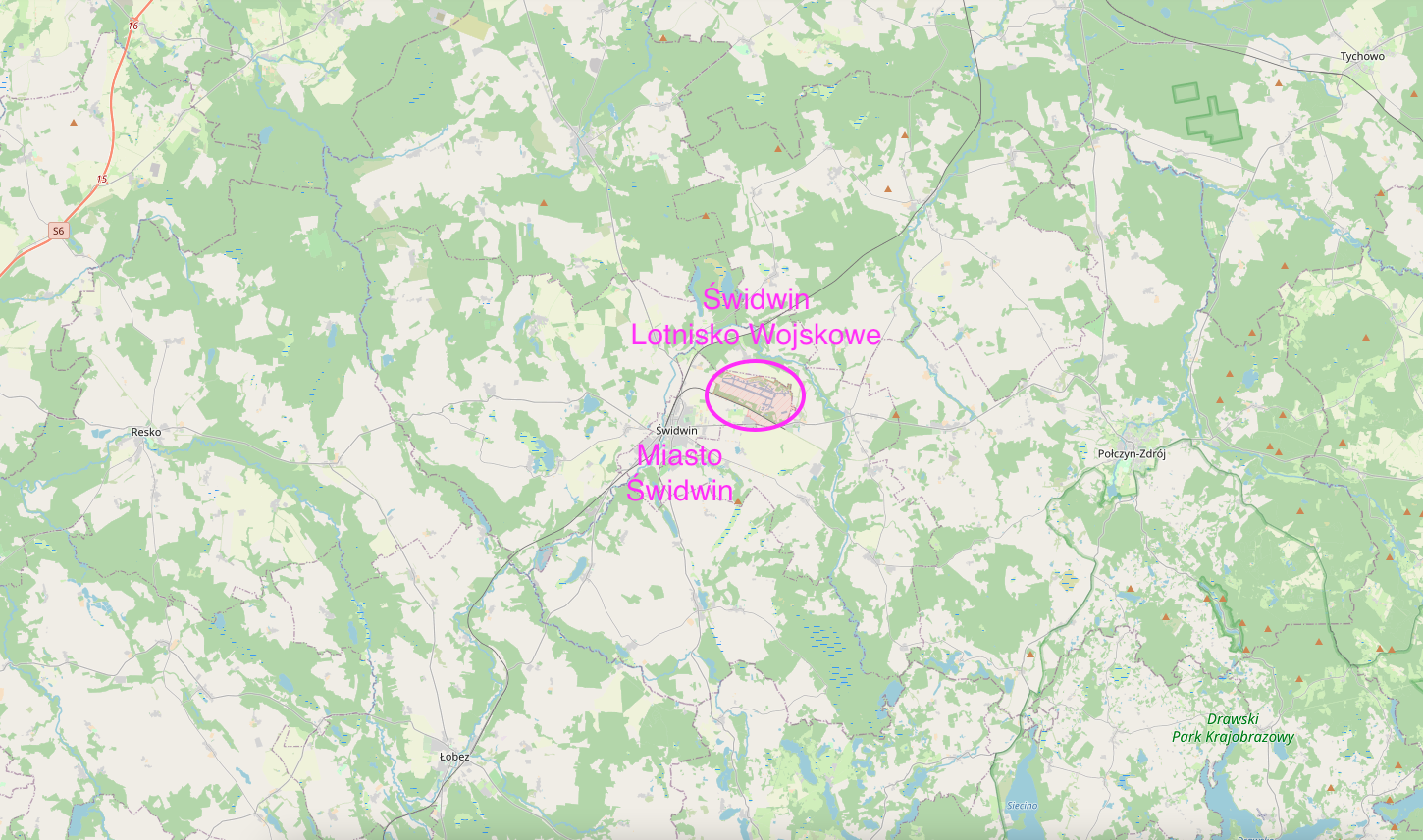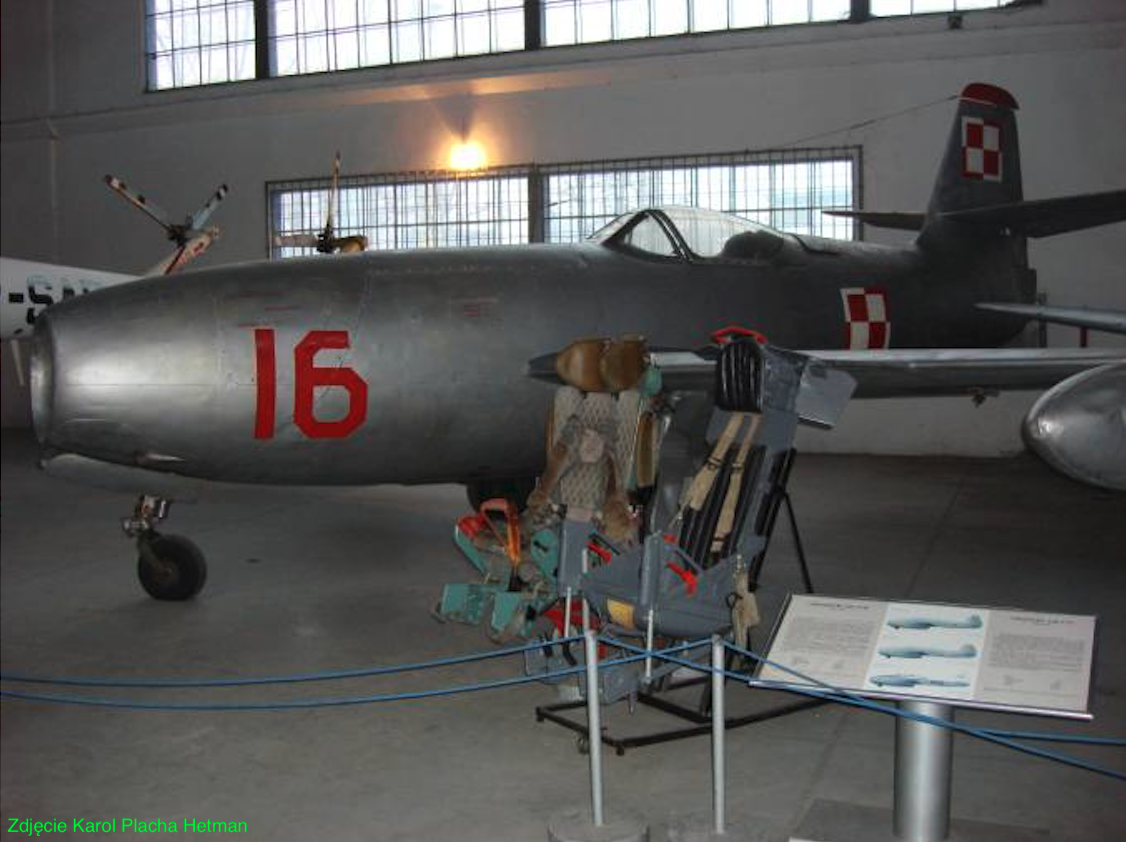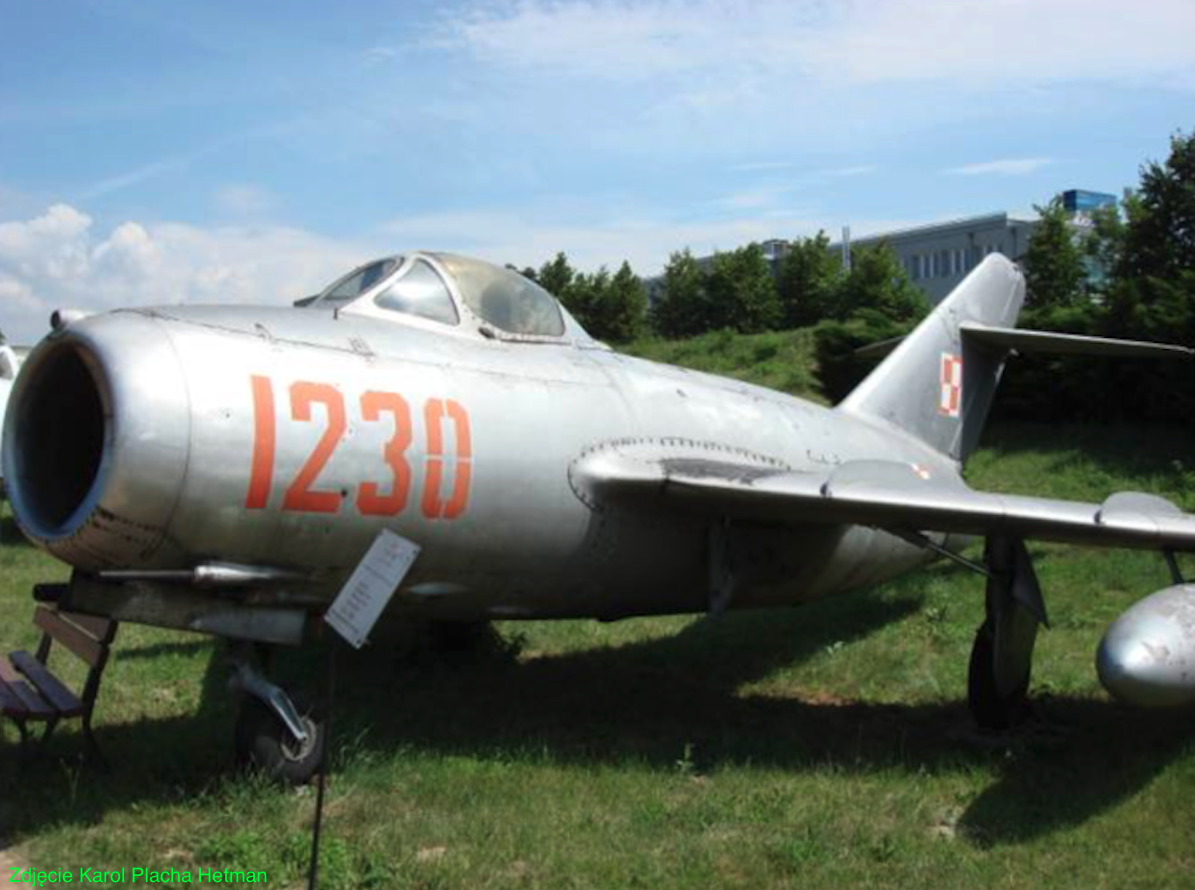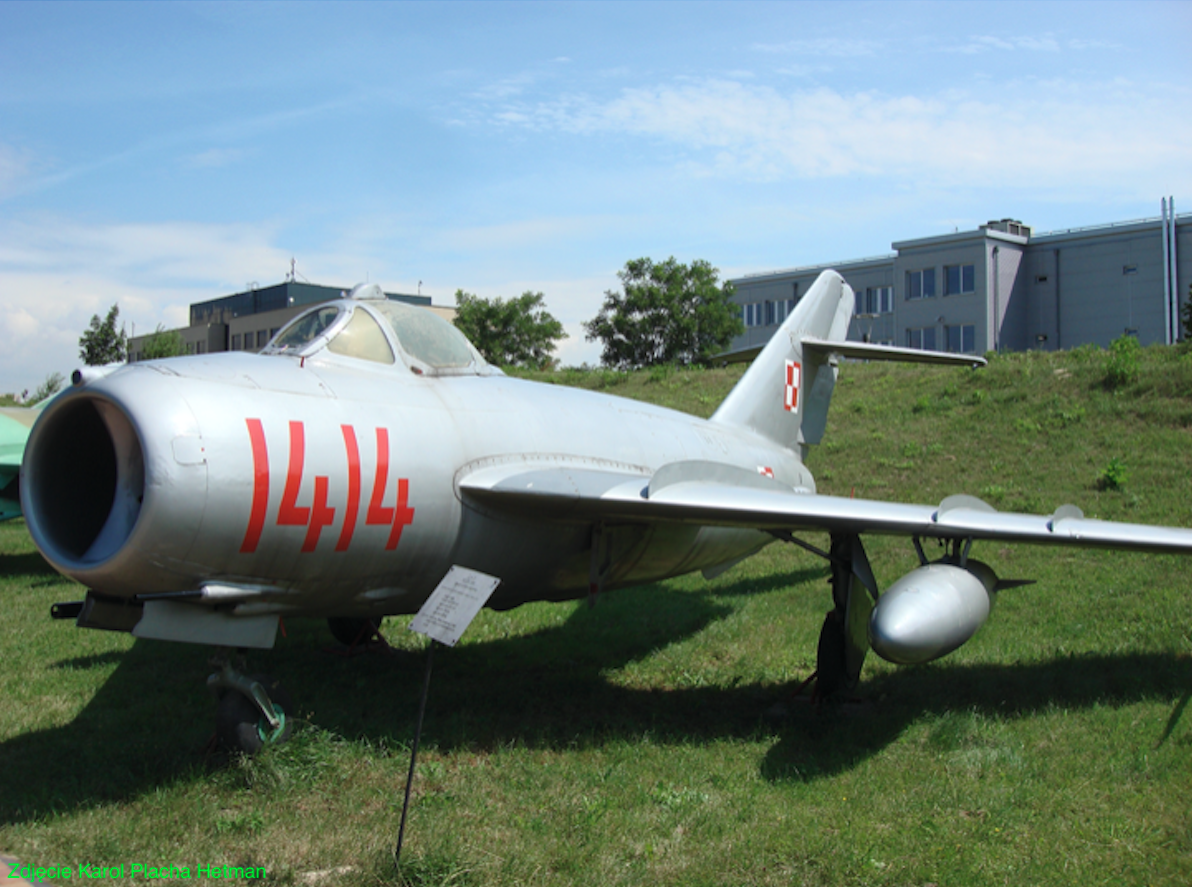Świdwin 2012-07-26
Lotnisko w Świdwinie. 2012 rok.
Współrzędne geograficzne: 53.791N 15.826E.


Lotnisko Świdwin 2011 rok. Praca Karol Placha Hetman
Miasto Świdwin.
Świdwin jest siedzibą Miasta, Powiatu i Gminy. Siedziba Powiatowej Komendy Policji oraz Powiatowej Komendy Straży Pożarnej. Miasto leży w północno-zachodniej Polsce, w Województwie Zachodniopomorskim. Położone jest na Wysoczyźnie Łobeskiej nad rzeką Regą, przy drogach wojewódzkich: nr 151, nr 152, nr 162. W granicach administracyjnych Miasta znajduje jezioro Bukowiec. Według danych z 30.06.2010 roku, Miasto liczyło 15 503 mieszkańców. W latach 1975 – 1998, Miasto administracyjnie należało do województwa koszalińskiego. Części Miasta stanowią także miejscowości: Buczyna, Rycerskie Dobra, Szczytniki, Świdwinek. Według danych z 1.01.2009 roku, powierzchnia Miasta wynosi 22,38 km kwadratowych. Miasto stanowi 2,06 % powierzchni powiatu, 41 % powierzchni Miasta zajmują użytki rolne, a 4 % użytki leśne. Świdwin jest ośrodkiem przemysłu spożywczego, drzewnego, maszynowego, przetwórstwa tworzyw sztucznych i do niedawna dziewiarskiego. A przede wszystkim jest Wojskowym Garnizonem.
Po drugiej wojnie światowej, wielcy tego świata zdecydowali o włączeniu Pojezierza Pomorskiego do Polski, a więc także i Świdwina. Miasto pierwotnie nosiło nazwę Świbowina i dopiero po konsultacjach z polskimi naukowcami, rozporządzeniem ministrów Administracji Publicznej i Ziem Odzyskanych z dnia 7.05.1946 roku, wprowadzono nazwę Świdwin. W latach 1946-1947, wysiedlono pozostałych germańców.
11 Dywizja Lotnictwa Myśliwskiego. 1951 rok.
Ze Świdwinem nierozerwalnie związana była 11. Dywizja Lotnictwa Myśliwskiego, a następnie kolejne związki taktyczne, aż do 1. Skrzydła Lotnictwa Taktycznego. Jak już wielokrotnie wspominaliśmy, z powodu wojny w Korei, blokady Berlina i innych konfliktów, Moskwa zmusiła nas do formowania kolejnych związków i jednostek bojowych. 11. Dywizja Lotnictwa Myśliwskiego jest tego przykładem. Sztab Generalny Wojska Polskiego rozkazem nr 0096/Org z dnia 11.12.1951 roku, nakazał sformowanie nowych związków taktycznych, w tym 11 DLM. Rozkaz zakładał podporządkowanie 11 DLM (JW. 3316 Świdwin etat 6/126) następujących jednostek: 11. Pułk Lotnictwa Myśliwskiego w Zegrzu Pomorskim, dotychczas na Ławicy (JW. 3779 etat 6/100). 24. Pułk Lotnictwa Myśliwskiego w Świdwinie (JW. 4600 etat 6/100). 27. Pułk Lotnictwa Myśliwskiego w Świdwinie (JW. 4519 etat 6/100). 76. Kompania Łączności w Świdwinie (etat 6/102). 47. Ruchome Warsztaty Remontowe Lotnictwa w Świdwinie (JW. 4496 etat 35/139).
Jednostki wojskowe miały być sformowane w okresie od maja 1951 roku do grudnia 1951 roku. Trudna sytuacja ekonomiczna kraju spowodowała, że realizacja tego rozkazu stała się niemożliwa. Opracowano nowy rozkaz 0078/Org z dnia 19.11.1952 roku, który zakładał formowanie lotniczych związków taktycznych w składzie dwóch pułków. W myśl tego rozkazu zaniechano formowania 24 i 27 PLM, ale tworzenie 11. DLM trwało dalej. Liczono, iż w przyszłości nowe jednostki powstaną. 11 PLM (JW. 3779) włączono w skład 6. Dywizji Lotnictwa Myśliwskiego. 11. Dywizja Lotnictwa Myśliwskiego zmieniła etat z 6/126 na 6/124.
Wówczas 11. DLM został podporządkowany: 26. Pułk Lotnictwa Myśliwskiego (JW. 5069) z 9. DLM, któremu jako miejsce stałej dyslokacji wyznaczono Zegrze Pomorskie. 40. Pułk Lotnictwa Myśliwskiego (JW. 1958), który przeszedł z 7. DLM. Miejscem stałego bazowania 40. PLM i pozostałych jednostek dywizji stał się Świdwin. Dodatkowo sformowany został Pluton Fotograficzny 11. DLM. Na potrzeby szkolenia personelu latającego rozkazem DWL nr 02/Org. z 3.03.1953 roku, został sformowany poligon lotniczy nr 6 w Podborsku. Za datę powstania 40. PLM przyjmuje się dzień 17.04.1951 rok.
Historia Lotniska Świdwin.
Historia Lotniska Świdwin sięga początku 50-lat XX wieku. Cały czas było bazą dla 40. Pułku-Eskadry, która jednak przechodziła swoistą metamorfozę, nie mającą odpowiednika w innych Polskich jednostkach lotniczych. Początkowo był to 40. Pułk Lotnictwa Myśliwskiego. Następnie 40. Pułk Lotnictwa Szturmowego. Później 40. Pułk Lotnictwa Myśliwsko-Bombowego, a w końcu 40. Eskadra Lotnictwa Taktycznego.
Od 1952 roku, 2. PLM z samolotami Jak-23 rozpoczął swoją działalność na krakowskim lotnisku Rakowice-Czyżyny. Samolotami szkolnymi były Jak-17 W, nazywane Agata. Dowódcą jednostki w tym czasie był Jan Frej-Bielecki. Na bazie stanu osobowego 2. PLM zaczynają być organizowane kolejne dwa pułki myśliwskie, stanowiące wraz z nim 7. DLM OPL. Był to 39. PLM i 40. PLM. Pierwszym dowódcą 40. PLM był por Arkadiusz Czapliński (oficer sowiecki). Dla nowo tworzonych pułków powstało lotnisko Mierzęcice, w pobliżu Katowic. Tak, więc październik 1951 roku, oraz Kraków są miejscem rozpoczęcia działalności 40 PLM. Już w lutym 1952 roku, Pułk przeniesiono do Mierzęcic. Zgodnie ze zmianami, o których napisaliśmy powyżej, 40. PLM został podporządkowany 11. Dywizji Lotnictwa Myśliwskiego w Świdwinie, dlatego musiał być tam przebazowany.
Z lotniska Mierzęcice 40. PLM z samolotami Jak-23, rzutem powietrznym został przebazowany do Świdwina w dniu 17.01.1953 roku. Jednym z pierwszych pilotów, który wylądował na lotnisku w Świdwinie był płk pilot Józef Olesiejuk. Od tego dnia na stałe (kilka dziesięcioleci) 40. Pułk związał się ze Świdwinem. Tu także umieszczono dowództwo Dywizji.

Jak-23 nb 16. 2008 rok. Zdjęcie Karol Placha Hetman
50-lata XX wieku.
Od sierpnia 1953 roku do grudnia 1953 roku, personel latający i techniczny 26 i 40 PLM został przeszkolony na samolotach MiG-15 / Lim-1, które zastąpiły samoloty Jak-23. Oprócz tego w pułkach Dywizji nadal eksploatowano małą ilość samolotów Po-2, Ut-2 oraz Jak-18.

Lim-1 nb 712. 2010 rok. Zdjęcie Karol Placha Hetman
Na potrzeby 11. DLM w dniu 3.02.1953 roku, został utworzony poligon lotniczy Nr 6 w Podborsku. Dla zabezpieczenia radiotechnicznego 11 DLM zarządzeniem Szefa Sztabu Generalnego WP nr 0277/Org. z 7.08.1953 roku, w Świdwinie sformowano Węzeł Radiotechniczny.
W 1954 roku, po licznych perturbacjach, ostateczny skład 11. Dywizji Lotnictwa Myśliwskiego przedstawiał się następująco: Dowództwo 11. Dywizji Lotnictwa Myśliwskiego. JW 3316 Świdwin (etat 6/124). 76. kompania łączności – Świdwin (etat 6/102). Węzeł Radiotechniczny – Świdwin (etat 6/191). 26 Pułk Lotnictwa Myśliwskiego – JW 5069 Zegrze Pomorskie (etat 6/165). 40. Pułk Lotnictwa Myśliwskiego – JW 1958 Świdwin (etat 6/165). 9 batalion obsługi lotnisk – JW 3829 Świdwin. Była to jednostka, która powstała zanim zaczęło funkcjonować Lotnisko Świdwin. 10 batalion obsługi lotnisk – JW 3895 Zegrze Pomorskie. Jednostka powołana z chwilą budowy Lotniska Zegrze Pomorskie. 7 dywizjon zabezpieczenia ślepego lądowania – JW 2571 Świdwin. 47 Ruchome Warsztaty Remontu Lotnictwa – JW 4496 Świdwin (etat 35/139). Poligon Lotniczy nr 6 – Podborsk (etat 6/181).
W 1954 roku, na zarządzenie Szefa Sztabu Generalnego WP nr 0138/Org z dnia 11.06.1954 roku, Dowódca 11 DLM sformował w Świdwinie klucz holowniczy (według etatu 6/204). Jednostka ta miała za zadanie zabezpieczać szkolenie jednostek artylerii Wojsk Obrony Przeciwlotniczej Obszaru Kraju oraz szkolenie lotnicze w strzelaniu do lecących celów. Po trzech miesiącach klucz powiększono i zarządzeniem Szefa Sztabu Generalnego WP nr 0182/Org. z 11.09.1954 roku, przeformowano na 19 Samodzielną Eskadrę Holowniczą (JW 2271 Świdwin wg etatu 6/208).
Na początku 1955 roku, dywizję i oba pułki myśliwskie przygotowano do przyjęcia samolotów Lim-2. Zmiana była o tyle istotna, że teraz 26 i 40 PLM otrzymywały samoloty prosto z Polskiej fabryki z Mielca.

Lim-2 nb 1230. 2007 rok. Zdjęcie Karol Placha Hetman
Zarządzeniem Szefa Sztabu Generalnego WP nr 0304/Org. z 28.12.1955 roku, w składzie Dywizji na bazie Węzła Radiotechnicznego 11. DLM sformowano w Świdwinie 19. kompanię radiotechniczną.
W 1955 roku, 40. PLM osiągnął gotowość bojową. Zdolność bojową jako związek taktyczny Dywizja osiągnęła pod koniec 1956 roku. Przyczyną tak długiego okresu dochodzenia do pełnej zdolności bojowej był brak dostatecznej ilości pilotów oraz ich niski poziom wyszkolenia spowodowany zaniżeniem wymagań wobec kandydatów, a przede wszystkim złym systemem komunistycznym, który nie chciał w kraju Polaków o rodowodzie z II Rzeczypospolitej Polskiej, a tym bardziej walczących na frontach zachodniej Europy.
W 1956 roku, na mocy rozkazu MON nr 045/Org. z 16.10.1956 roku, Dywizja została podporządkowana Dowódcy 3. Korpusu Lotnictwa Mieszanego.
W dniu 14.11.1957 roku, ukazał się Rozkaz MON Nr 098/Org., Według którego 26. PLM z Zegrza Pomorskiego wyszedł z 11. DLM, a w jego miejsce został podporządkowany 4. PLM, który stacjonował w Goleniowie. Dla 40. PLM nie miało to jednak większego znaczenia, lecz należy pamiętać, że cała 11. DLM działa w systemie Lotnictwa Operacyjnego, czyli w sytuacji „W” stałaby się Armią Lotniczą i działa jako element ofensywny.
W 1958 roku, z Dywizji wyprowadzono 19. eskadrę holowniczą, którą przekazano w podporządkowanie Dowódcy 2 Korpusu Obrony Przeciwlotniczej Obszaru Kraju. Stało się to rozkazem Dowódcy WOPLOK nr 016/Org. z 18.12.1958 roku.
Podstawowym myśliwcem w 40. PLM były samoloty Lim-1/2. Stopniowo z końcem 50-tych lat, 40 PLM zwiększył swój potencjał militarny. W czerwcu 1959 roku, Pułk otrzymał 2 samoloty MiG-17 PF, z 28 PLM OPL OK, ze Słupska. Były to pierwsze myśliwce wyposażone w stację radiolokacyjną. Wiosną 1960 roku, do Pułku trafiły pierwsze samoloty Lim-5, Polskie odpowiedniki radzieckich MiG-17. Około 8 egzemplarzy. Samoloty nie miały stacji radiolokacyjnej. Również w 1960 roku, Pułk otrzymał jeden egzemplarz Lim-5 P, ze stacją radiolokacyjną. W 1961 roku, Pułk miał już na stanie jedną eskadrę, czyli 12 maszyn Lim-5 P, w tym 2 samoloty MiG-17 PF.

Lim-5 nb 1414. 2007 rok. Zdjęcie Karol Placha Hetman
Ciąg dalszy jest w kolejnym rozdziale.
Opracował Karol Placha Hetman
